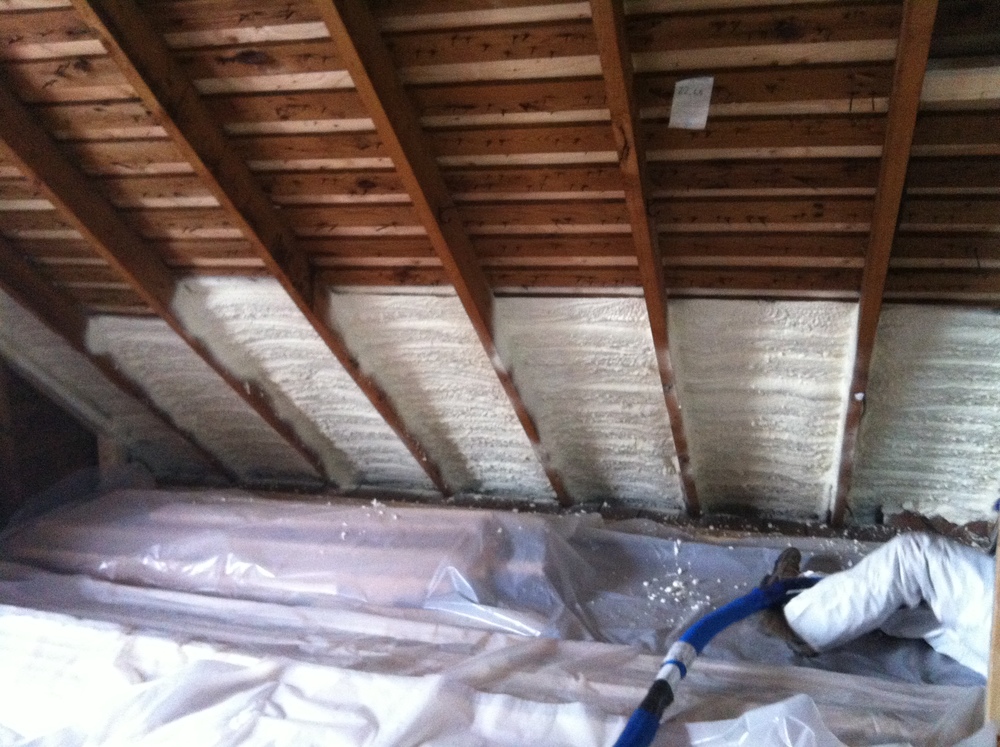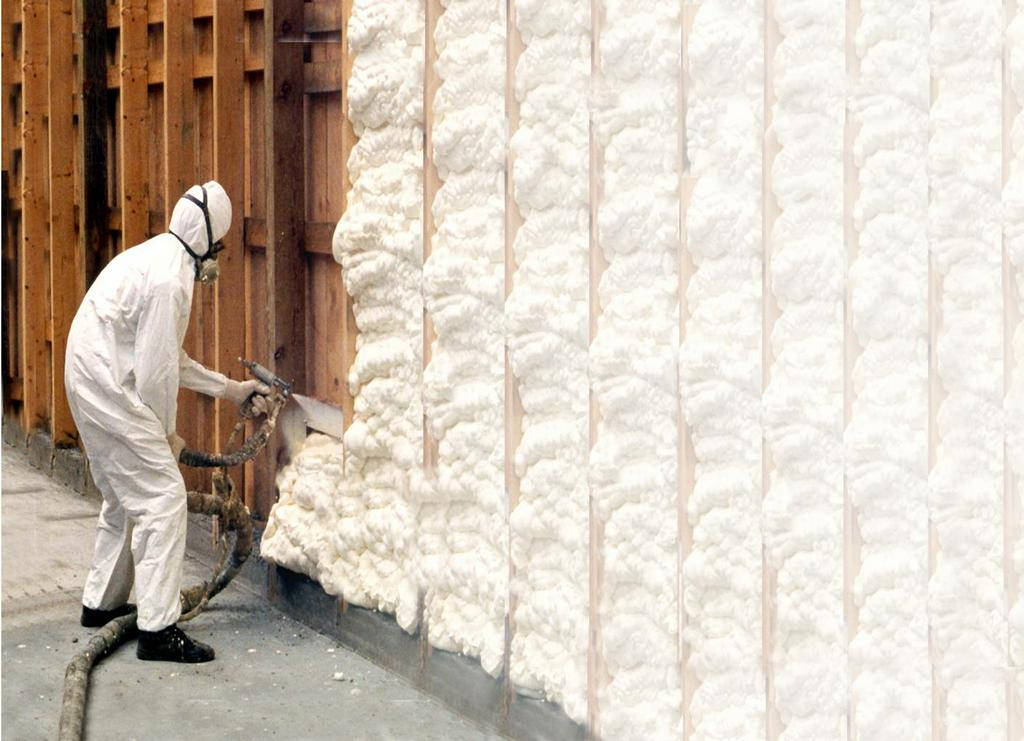The Process of Applying Spray Foam: What You Need to Know
The Process of Applying Spray Foam: What You Need to Know
Blog Article
Just How Spray Foam Can Enhance Energy Performance in Any Building
Spray foam insulation has actually become an essential solution for enhancing energy performance across various structure kinds. By creating a closed seal that lessens air leak, it efficiently controls interior environments while considerably minimizing home heating and air conditioning costs. Moreover, its excellent R-value and moisture-resistant homes contribute to lasting energy cost savings and boosted building durability. As building owners significantly look for sustainable solutions, the implications of spray foam insulation extend beyond mere utility savings. The full scope of its advantages, nonetheless, warrants a more detailed examination of just how it can change power administration methods in both industrial and domestic settings.
Understanding Spray Foam Insulation
Spray foam insulation is increasingly identified for its remarkable thermal performance and flexibility in different applications. Made up largely of polyurethane, this insulation material is applied as a fluid that broadens upon contact, loading spaces and creating a smooth barrier. This one-of-a-kind building enables spray foam to satisfy uneven surfaces, making it an excellent option for both business and domestic structures.

Application of spray foam insulation is typically carried out by experienced professionals utilizing specific tools, ensuring ideal efficiency and safety and security - Spray Foam. The healing process is rapid, permitting fast installment and minimal disruption. Therefore, spray foam insulation is progressively being used in brand-new building and construction and retrofitting projects due to its ability to boost architectural honesty while improving overall energy efficiency in buildings
Benefits of Energy Effectiveness
Power performance plays a crucial duty in minimizing functional expenses and reducing environmental influence throughout different industries. By optimizing energy usage, house owners and companies can achieve substantial savings on energy bills, which straight enhances monetary efficiency. Effective energy usage means less reliance on nonrenewable fuel sources, consequently adding to a reduction in greenhouse gas emissions and advertising a much more sustainable atmosphere.
Moreover, energy-efficient buildings typically experience boosted building values. As energy prices rise and sustainability ends up being a concern for consumers, buildings with improved power performance functions are much more eye-catching on the marketplace. This pattern encourages financial investment in energy-saving innovations, which can even more drive technology and economic growth.
In addition to financial and ecological advantages, power performance can likewise enhance the total convenience and wellness of indoor areas. Appropriate insulation and reliable heating and air conditioning systems help preserve constant temperatures, lowering drafts and moisture levels, which subsequently can cause better interior air top quality.
Ultimately, the benefits of power effectiveness expand past instant financial savings, cultivating a durable economy, promoting environmental stewardship, and enhancing the quality of life for occupants in any type of building.
How Spray Foam Works
Usually used as a liquid, spray foam increases swiftly upon contact with surface areas, creating a solid barrier that effectively seals splits and gaps. This unique residential or commercial property results from its chemical structure, mostly including polyols and isocyanates, which react when mixed to produce a foam that fills spaces and sticks to different materials, consisting of steel, timber, and concrete.
When used, the foam broadens to a number of times its original volume, ensuring a limited seal that protects against air leak. This procedure substantially minimizes thermal connecting, which occurs when warm transfers with products, causing power loss. The foam's high R-value, a step of thermal resistance, adds to boosted insulation by decreasing warm transfer in between the interior and outside environments.
Additionally, spray foam is immune to moisture and parasites, even more boosting its efficiency in keeping power effectiveness. Its application can be customized to various areas, including attic rooms, wall surfaces, and crawl rooms, maximizing insulation across a structure. Spray Foam. In general, the cutting-edge design and application technique of spray foam make it click here for more info an efficient option for enhancing energy effectiveness in any kind of structure, causing minimized power expenses and an extra sustainable built environment

Applications in Numerous Structures
Many applications of spray foam insulation can be found throughout different building kinds, improving energy effectiveness and comfort. In property homes, spray foam is commonly utilized in wall surfaces and attics to produce a smooth barrier versus air leakages, considerably lowering heating and cooling down needs. This application is especially valuable in older homes, where typical insulation might be inadequate.
In commercial structures, spray foam insulation is put on roof systems and exterior wall surfaces, which assists to boost thermal performance and safeguard versus moisture invasion. Its lightweight nature makes it an excellent choice for this hyperlink retrofitting existing structures without including considerable weight. In addition, spray foam can be used in commercial settings to shield pipes and tank, keeping temperature control for delicate materials.
Institutional structures, such as healthcare facilities and institutions, advantage from spray foam insulation by making sure a constant interior climate that sustains owner convenience and health and wellness. The convenience of spray foam permits it to adjust to different building sizes and shapes, making it a recommended selection for architects and contractors seeking efficient insulation services. Generally, spray foam insulation functions as a vital component in accomplishing energy-efficient buildings across all sectors.
Long-Term Expense Savings
Spray foam insulation supplies substantial long-lasting expense financial savings for structure owners and owners by decreasing power usage and decreasing energy expenses. By offering a remarkable air seal, spray foam minimizes the seepage of outside air, consequently boosting the thermal efficiency of a structure. This causes a lot more effective home heating and cooling procedures, which can result in substantial decreases in energy prices over time.
Along with prompt savings on utility bills, the sturdiness and long life of spray foam insulation contribute to its economic benefits. Unlike conventional insulation products, which might sag, clear up, or wear away, spray foam keeps its performance for decades, minimizing the need for frequent substitutes or repair services. This longevity equates to decrease maintenance expenses and much less disruption for passengers.
Moreover, buildings outfitted with spray foam insulation frequently take pleasure in a rise in building value, making them much more attractive to possible customers or tenants. As energy effectiveness becomes progressively prioritized, residential or commercial properties with efficient insulation options attract attention in the market. Ultimately, the combination of spray foam insulation not only improves convenience however additionally stands for a critical financial investment that yields significant financial benefits over the long-term.
Conclusion
In conclusion, spray foam insulation functions as an important component in enhancing energy efficiency throughout varied building types. Its capability to develop a seamless barrier versus air leak, incorporated with high R-values and moisture-resistant residential or commercial properties, substantially minimizes energy consumption and associated prices. The execution of spray foam not just contributes to consistent interior temperatures but additionally raises building worth, highlighting its role as a sensible financial investment for both commercial and household buildings.
Spray foam insulation has emerged as a crucial Recommended Reading option for enhancing power effectiveness across numerous structure kinds. Spray Foam. As a result, spray foam insulation is significantly being utilized in brand-new building and construction and retrofitting jobs due to its capacity to improve structural stability while improving total energy performance in buildings
Overall, the ingenious design and application technique of spray foam make it an effective option for improving power efficiency in any type of structure, leading to minimized energy expenses and an extra sustainable constructed environment.
Many applications of spray foam insulation can be found across numerous building types, boosting energy effectiveness and convenience.In conclusion, spray foam insulation offers as a vital element in improving power efficiency throughout varied building types.
Report this page